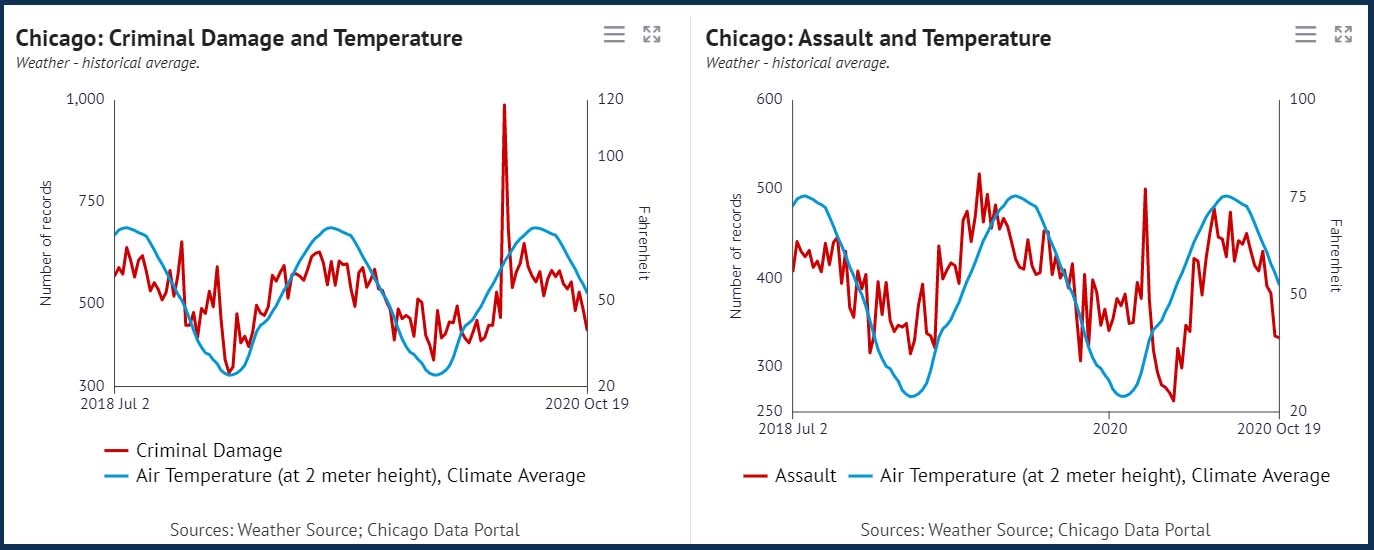Summer is here and the living is easy, or so they say. Everyone enjoys the warmer weather and sunshine, and it appears that criminals do too. Have you noticed that crime tends to rise during the summer months? Recent research has tied a rise in crime rates to an environmental factor – the weather.
A recent comparison of crime and temperature data across ten major U.S. cities found that temperature changes were responsible for 10 percent of fluctuations in the nation’s crime rates. Looking only at the number of shootings, the investigation found that as temperatures rose, so did the number of shooting victims in nine out of the ten cities.
Let’s take a look at Chicago, for instance. Police crime data from the City of Chicago Data Portal shows that within the annual summer crime peak, certain types of crime appear more weather-dependent. Out of seven major crime categories, theft, along with shootings and other battery, saw the greatest increase as temperatures rose, with nine additional incidents for every 10-degree temperature increase. Other categories of crime are connected to a lesser extent, including criminal damage (five more incidents per 10-degree increase) and assault (three additional incidents).
Knoema, a Weather Source partner, provides tools to visualize, model and present data to facilitate better decisions and better outcomes. Knoema analyzed and correlated Weather Source data with crime statistics and assembled into an easy to digest visualization. Knoema has done other intensive research into other economic activities from crop yield, commodity prices, power generation of renewable energy sources such as wind farms and solar stations.
Continuing the focus on Chicago (above), Knoema’s analysis of weather data from Weather Source and crime statistics from the Chicago Data Portal shows that the intensity of some (but not all) types of criminal activity correlates highly with weather conditions, such as:
- Traders and criminals alike are influenced by the weather; warm air temperatures and blue skies seem to align with most types of criminal activities. Criminal damage and air temperature have the highest correlation (correlation coefficient: 0.84) among the types of crime and weather indicators available in our data sample. Similarly, instances of criminal damage are highly, but negatively, correlated with cloudy conditions (-0.8).
- Of all types of crime, criminal damage is the only one “highly” correlated (above 0.5 or lower than -0.5) with all weather indicators.
- Other interesting observations: The higher the sea level pressure, the lower the homicide rate (0.67). And cloud cover is the most significantly related weather condition for gambling.
 Visualization of images courtesy of Knoema, correlating temperature increases and crime rates.
Visualization of images courtesy of Knoema, correlating temperature increases and crime rates.
Knoema notes that the relationships described present potentially troublesome social implications when ongoing global warming is taken into account. The data may reveal more on this subject in the next two to three decades.
Preparing for Weather and Increased Crime
In their abstract, The Effects of Weather on Crime, James Horrocks, and Andrea Kutinova Menclova (both with the Department of Economics and Finance at the University of Canterbury) concluded that temperature and precipitation both have a significant effect on the number of violent crimes recorded and temperature has a significant effect on the number of property crimes recorded.
Their results suggest that police should respond to weather changes characterized by increases in temperature and/or decreases in precipitation by increasing the resources allocated to policing on those days. And when allocating its resources, police should use information on both district and seasonal characteristics and current weather conditions (from short-term weather forecast) into account.
Forecasting models, both short-term and long-term, yield better-informed decisions to improve operational and organizational efficiency. Entities that incorporate this fundamental data into their business intelligence can easily apply this data and generate insights to discover how weather impacts crime.
Using weather tools such as OnPoint Weather, these entities would have access to a dataset that consists of a curated continuum of historical data from the year 2000 to present, current data, and forecast data of up to 15 days with an extended and enhanced forecast going out 42 days. By looking at past weather data correlated with crime data, entities can ingest what has happened in the past during warmer temperatures. In turn, looking at forecast modeling, they will also be able to see what is coming down the line and, as Horrocks and Menclova mentioned, be able to allocate fundamental resources if a surge is anticipated.
Weather Source data can be easily correlated with crime statistics in major cities. Doing so could help cities, police departments and other entities anticipate when crime would increase dependent on the weather.
By combining Knoema tools and Weather Source OnPoint Weather data, it is possible to accurately create predictive models as to where to anticipate crime “hot spots.” To learn more, contact one of our experts.



